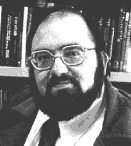Roy Childs
| Roy Alan Childs, Jr. | |
|---|---|
 Childs in the 1980s | |
| Born |
January 4, 1949 Buffalo, New York |
| Died |
May 22, 1992 (aged 43) Miami, Florida |
| Occupation | Essayist, editor |
| Language | English |
| Citizenship | United States |
| Period | 1967–1992 |
| Subject | Politics |
Roy Alan[1] Childs, Jr. (January 4, 1949 – May 22, 1992) was an American libertarian essayist and critic.
Career
Childs counted among his early influences Ayn Rand, Ludwig von Mises, Rose Wilder Lane, and Robert LeFevre.
In his essay, "An Open Letter to Ayn Rand," Childs rejected Objectivism as being true libertarianism, asserting that the establishment of government is in violation of self-ownership and the non-aggression principle.[2] In the 1960s, Childs endorsed anarcho-capitalism, but later expressed doubts about anarchism.[3] In the 1960s, Ayn Rand wrote an essay entitled "America's Persecuted Minority: Big Business." Childs responded with an essay entitled "Big Business and the Rise of American Statism." He wrote, "To a large degree it has been and remains big businessmen who are the fountainheads of American statism."[4] Childs edited the magazine Libertarian Review from 1977 until it folded in 1981. He was also a research fellow and later a policy analyst with the Cato Institute from 1982 to 1984. Perhaps Childs's most visible public role was as lead book reviewer for Laissez Faire Books, in which position he produced a number of memorable short essays. He held this position from 1984 until his death.
Personal life
Childs was born in Buffalo, New York on January 4, 1949.[5] After graduating high school, he enrolled at the State University of New York at Buffalo, with the intention of eventually becoming a college professor. While there, he was offered a full scholarship to attend Rampart College in Larkspur, Colorado, an unaccredited college established by Robert LeFevre to educate students on libertarian views. However, LeFevre's project collapsed soon after Childs arrived, and by the fall of 1968 he was back at SUNY Buffalo.[6]
For many years, Childs suffered from difficulties due to obesity. In later years, when he lived in New York City, he sometimes weighed over 400 pounds, and rarely left his apartment. Childs went to the Pritikin Center in Miami, Florida, to take part in a weight loss program. While there he fell and was taken to a local hospital, where he died on May 22, 1992, at the age of 43.[7][8]
Legacy
Following his death, pundit Tom G. Palmer wrote of him, "Roy Childs was one of the finer members of a generation of radical thinkers who worked successfully to revive the tradition of classical liberalism ... and who dared to launch a frontal challenge to the twentieth-century welfare state ... his writings exercised a powerful influence on a generation of young classical liberal thinkers."[9]
After his death, the Cato Institute named its in house library after Childs – it contained many volumes from Childs' collection. His personal papers are in an archive at Stanford University.[10] The Center for Independent Thought offers a "Roy A. Childs, Jr. Fund for Independent Scholars", which supports non-academic classical liberal writers.[11]
Works
Childs wrote essays and book reviews, which were collected posthumously into anthologies:
- Taylor, Joan Kennedy, ed. (1994). Liberty Against Power. San Francisco: Fox and Wilkes. ISBN 0-930073-13-4. OCLC 34131336. – a paperback collection; includes an introduction by Thomas Szasz and a biographical sketch by Taylor.
- Childs Jr., Roy A. (2012). Anarchism & Justice. Washington, D.C.: Libertarianism.org Press. ISBN 978-1-938048-73-9. – an e-book collection with an introduction by George H. Smith.
References
- ↑ Riggenbach 2011
- ↑ Archived October 12, 2012, at the Wayback Machine.
- ↑ http://www.thornwalker.com/ditch/eboa_preface_5.htm
- ↑ http://www.amconmag.com/blog/libertarian-left/
- ↑ Taylor 2008, p. 61
- ↑ Taylor, Joan Kennedy. "Roy A. Childs: A Biographical Sketch". In Childs 1994, p. xiv
- ↑ Taylor, Joan Kennedy. "Roy A. Childs: A Biographical Sketch". In Childs 1994, p. xviii
- ↑ Mariotti 2013
- ↑ Quoted in Taylor, Joan Kennedy. "Roy A. Childs: A Biographical Sketch". In Childs 1994, p. xviii
- ↑ Taylor 2008, p. 62
- ↑ "Roy A. Childs, Jr. Fund for Independent Scholars". Center for Independent Thought. Retrieved November 30, 2013.
Works cited
- Childs, Roy A., Jr. (1994). Taylor, Joan Kennedy, ed. Liberty Against Power. San Francisco: Fox and Wilkes. ISBN 0-930073-13-4. OCLC 34131336.
- Mariotti, Steve (July 2, 2013). "As DOMA Collapses, I Remember Libertarian Gay Activist Roy Childs". Huffington Post. Retrieved November 29, 2013.
- Riggenbach, Jeff (January 21, 2011). "The Story of Roy A. Childs Jr. (1949–1992)". Mises Daily. Ludwig von Mises Institute.
- Taylor, Joan Kennedy (2008). "Childs, Roy A. (1949–1992)". In Hamowy, Ronald. The Encyclopedia of Libertarianism. Thousand Oaks, CA: SAGE; Cato Institute. pp. 61–62. ISBN 978-1-4129-6580-4. LCCN 2008009151. OCLC 750831024.
External links
- An Open Letter to Ayn Rand at the Wayback Machine (archived October 12, 2012), written by Roy Childs.
- Biography at the Wayback Machine (archived April 23, 2010)
- Roy Childs papers
- Roy A. Childs Jr. at Goodreads